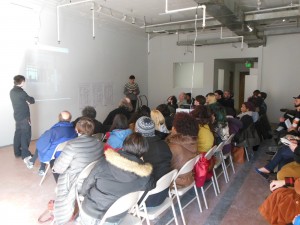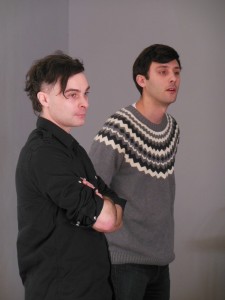Le Mondo Charrette offers public a peek at proposed Howard Street art space
This group of vacant buildings on North Howard Street may soon house a new arts facility. (Anthony C. Hayes)
Can a small cadre of young actors and artists really turn a blighted block around?
That was the unspoken question of the hour as some fifty people gathered on Saturday afternoon at the Current Gallery in Baltimore, Maryland, for an informational charrette about Le Mondo – a proposed new arts and theatre space in the 400 block of North Howard Street. The spirited meeting, which included a talk-back session where audience members could share their own ideas, was hosted by Ric Royer (Psychic Readings), Evan Moritz (Annex Theater), and Carly J. Bales (EMP Collective).
An ambitious undertaking, which Bales said should cost upwards of 8.5 million dollars, Le Mondo will incorporate six different local companies (EMP Collective, Annex Theater, Psychic Readings, Acme Corporation, Stillpointe Theatre Initiative, and Movement Research Baltimore), into a cooperative which would give the West Side the kind of central arts space the Creative Alliance provides patrons in Highlandtown. Once completed, Le Mondo will contain studios, a café and/or bar, a small bookstore and several theatre spaces.

The group estimates that the project would create 70 construction jobs and about 60 permanent positions.
The buildings in question are all currently boarded over. One was last the site of a Rite Aid, another a Korean/Japanese restaurant. The third housed a furniture store. In one of the structures, there was also a seedy night club. All of that would be ancient history if the eager young artists succeed in their goal to, “create a community-driven, artist-owned arts incubator, and three experimental performance venues.”
Evan Moritz told the Baltimore Post-Examiner the group initially approached the city with its intriguing idea, saying, ‘We need art space, and Howard Street looks great!’
“Our first contact with the city came before the RFP (request for proposals) was launched, so we consider ourselves fortunate-fortunate.”
Moritz said all six of the companies will eventually move into the proposed space – contingent on a number of factors, including the availability of funding; the progress of the space build-out; and the expiration of current leases at other locations.
“As Carly said (in her presentation), we’re looking at this as a three-year project with an estimated cost of 8.5 million dollars. The idea is to complete it in four separate phases. We expect the first phase to take about two years and run 1.5-2 million dollars, which will include our development costs and the actual first phase build-out. That’s the big one, because we’ll get a lot of this site structurally ready. In Phase II, we’ll be working on the café space, the bar, figuring out how we do our lobby; just trying to get that other income stream going and make the project sustainable. So we’ll be fund-raising to make that a reality.”

“In the subsequent phases, we’ll be looking at developing the second and third floors of the buildings – one at a time. They’ll each have their own price tag. We’re still looking at the 8.5 million dollar total, but the phase breakdown may slightly change how the financing works as time goes on. We don’t have the money right now, but we should hopefully see a million in Federal start money coming shortly to make the big first step. And we’re looking for those generous first donors.”
“The importance of getting in on the ground floor and getting activities in there can’t be overstated because that really helps us make a case for fund-raising and it helps us adapt to reality. All of our thoughts and plans right here may change the minute we step in there and start actually programing and get involved. But we want to make sure our eyes are open as wide as possible because we are doing something we clearly love.”
Moritz said that a big part of what is the artists’ “eyes open wide” approach has been to involve seasoned professionals in the challenging project.
“Ted Rouse has been a tremendous resource. I believe his company did the renovation work on the Congress Hotel, which is just around the corner from where we’ll be building. We meet with him almost every week to discuss the project, and to go over things like the funding, architect Peter Fillat’s ideas, etc. Ted has also been extremely helpful in talking with leaders in the business community; people that artists might not normally have access to.”
“Mark Wasserman with University of Maryland Medical has been very helpful, though there have been many others as well.”
Sarah Jacklin, a local actress, listened intently to the presentation. Excited about the prospects, she relayed a conversation she’d had just an hour before the meeting.
“I was on my way here and running late, so I grabbed a cab, and when I told the driver I was going to Howard Street, he said, “Oh, Howard Street, how sad – that used to be a place.” So of course, I told him why I was coming here to this organizational meeting about redeveloping these three properties under the name Le Mondo; that all those involved as leaders in the group are under 35, and they are trying to raise the money to turn these spaces which have trees growing through them into a really vibrant space to foster new work.”
Jacklin noted that the idea to revitalize the historic Howard Street business and theatre district (Le Mondo will be located about half a block south of the old Mayfair Theatre) ran off the tracks in the early 1980’s – more than ten years before the light rail system (which was also meant to help the area) began operation.

“I was doing some research recently and looking at the pitch from 1975 for Center Market. It said this area was guaranteed to be a long term retail hub, because it had those great fixtures of Hecht’s and Hutzler’s. The pitch was produced with many pages of glossy photos describing what was going to happen to the neighborhood. But I think both of those stores shut down less than five years later. Everything the city had riding on the area revolved around these two large fixtures of commerce, rather than what was happening with the smaller things in between them. So when they folded, the city had no idea how to maintain or attract people to the area.”
“I think it’s just proof that what we need to be watching are the small spaces; the ones that grow up in between the huge entities that the city is willing to give millions and millions in tax credits to. These small, artist run, individually run, entrepreneurial spaces are more important than your Under Armours for keeping this city healthy.”
Can a small cadre of young actors and artists really turn a blighted block around?
Only time will tell, but all agreed they are looking at Le Mondo with the future in mind.

Anthony C. Hayes is an actor, author, raconteur, rapscallion and bon vivant. A one-time newsboy for the Evening Sun and professional presence at the Washington Herald, Tony’s poetry, photography, humor, and prose have also been featured in Smile, Hon, You’re in Baltimore!, Destination Maryland, Magic Octopus Magazine, Los Angeles Post-Examiner, Voice of Baltimore, SmartCEO, Alvarez Fiction, and Tales of Blood and Roses. If you notice that his work has been purloined, please let him know. As the Good Book says, “Thou shalt not steal.”
